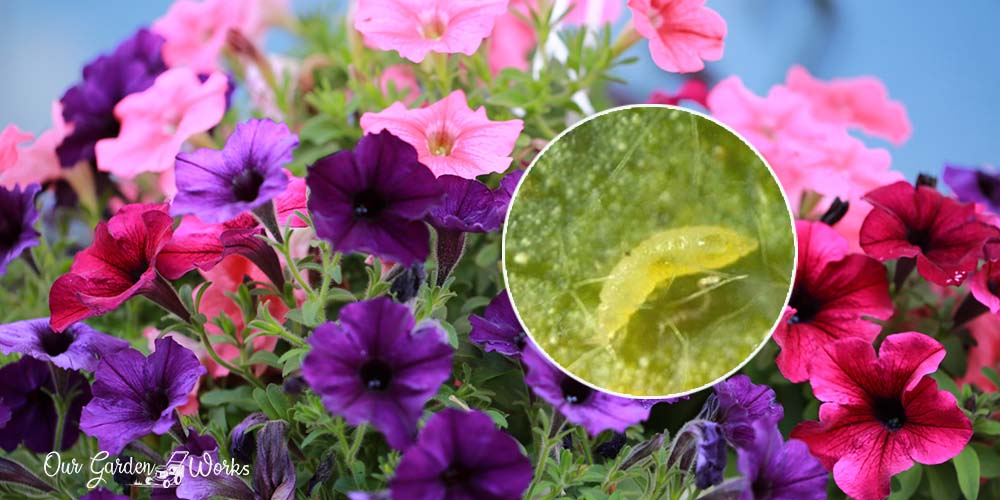Overflowing flowers, a fragrant floral scent, and vibrant colors make petunias the best plants to have on fences. When they are sick or looking unhealthy, most gardeners would immediately ask: what is eating my petunias? They are easy to grow but not bulletproof to pest damage.
Petunia is a gardener’s favorite because they are easy to grow and do not need much tending to be healthy and vigorous. However, no matter how healthy a plant can be, when a swarm of pests attacks, it can die too. This post will help you figure out which of the five notorious bugs or animals is eating your petunias.
We will recommend pest control and treatment for pest-damaged petunias. Before we start investigating the crime scene caused by pests in your garden, have you ever wondered why they love gnawing petunias so much?
Well, let us explain.
What Makes Petunias a Snack For Bugs and Wildlife Animals?
Petunias are notably among the favorite snack of sap-sucking insects. The leaves and flowers have thin cell walls that allow the insects to access their honeydew. There’s nothing special about petunias being swarmed by pests unless they are stressed or gravely neglected.
Like humans, the health of plants like petunias declines with excessive stress and lack of love. Healthy plants can repel pests naturally, and when they get weak, pests and diseases take advantage of them.
5 Notorious Culprits: What Is Eating My Petunias?
If you’ve been gardening for a while now, you may notice that every plant is infested with only a specific type of bug or wildlife animal. Some are infested with worms or larvae, while others are swarmed with soft-bodied insects like aphids.
Due to their color and juicy stems, petunias are, unfortunately, a snack for sap-sucking insects, worms, mites, and even wildlife animals. To be specific, here are the five notorious pests that have been sneakingly eating your petunias:
Budworms
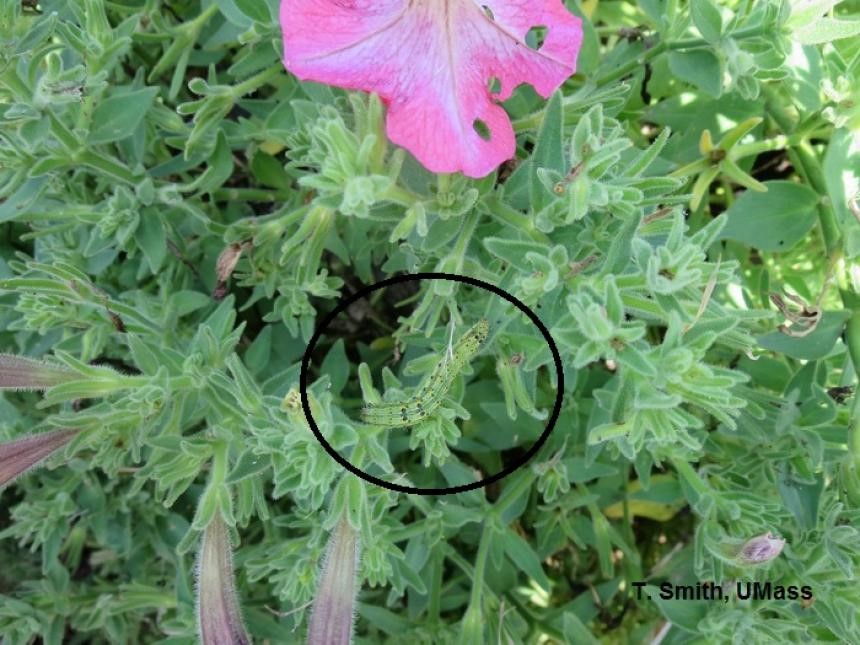
Budworms, a.k.a tobacco budworms or geranium budworms, are the culprits behind holes in buds, flowers, and leaves of petunias.
They target unopened buds, which cause malformed and chewed edges on the petals of the flowers. You will see them immediately crawling around the stems in petunia plants in late summer.
Tobacco budworms are the larvae of moths. They are around 1/8th of an inch to two inches long with hairy skin and a distinct line along the abdomen.
One specific behavior of tobacco budworms is they leave black specks or excrements on the buds. If you see black dots and a hole on the bud, then that is a budworm infestation.
You can easily see them crawling around the bushes of an infested petunia plant. Their color depends on the flowers they eat, but they usually have green, red, and purple colors.
For petunias, most of the worms are green. You can easily see them on the buds with a keen eye, so handpicking is one way to manage them.
How to control worms on petunias
If you see mangled flowers and holes on buds, your petunias most likely have a budworm infestation. Here are some steps that you can take to control them:
(1) Handpicking: The easiest and fastest way to deal with bud-damaging worms is handpicking them and drowning them in a bucket full of soapy water. Tobacco budworms often plague petunias at night and dusk.
(2) Using a Btk solution: Bt or Bacillus thuringiensis var. Kurstaki is a biological insecticide composed of soil-borne bacterium that kills worms upon ingestion. Budworms will only die if they ingest a leaf or a bud sprayed with Btk solution.
You may find some luck in using a Bt solution because they only attack worms and caterpillars and are safe for beneficial insects like bees. However, researchers from the University of Minnesota beg to differ.
The UM researchers acknowledge the efficiency of Bt in controlling caterpillars but not tobacco budworms in particular. They don’t chew enough Bt-coated leaves or petals to kill them.
Since they often feed deep into the buds, there are fewer chances that they will ingest the Bt solution that you’ve applied to your petunias.
(3) Using bifenthrin and spinosad solution: Instead of Bt petunia growers, recommend using bifenthrin and spinosad insecticides to thoroughly control tobacco budworms. They are contact insecticides that paralyze insects and worms by contact and ingestion.
On a side note, bifenthrin is a synthetic pyrethroid and may harm even beneficial insects. Whereas spinosad is a chemical from a soil bacterium somewhat similar to Bt but stronger and has longer residual activity.
Aphids, Thrips, and Mealybugs
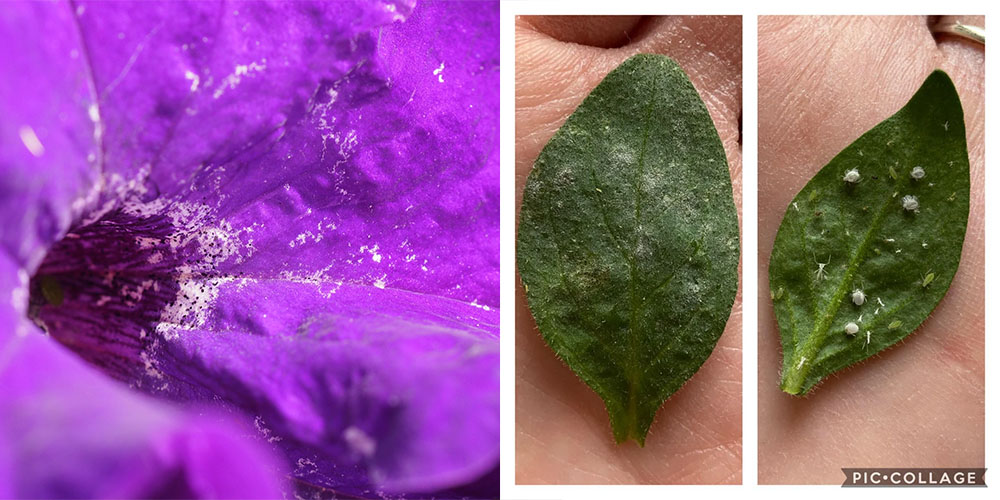
After the notorious munchers of buds, we have the second popular pests on petunias – sap-sucking insects! They are the specks of black and white crawling around buds, stems, and leaves of petunias. In small populations, they rarely affect the health of petunias, but a swarm of these tiny insects can suck the life out of them.
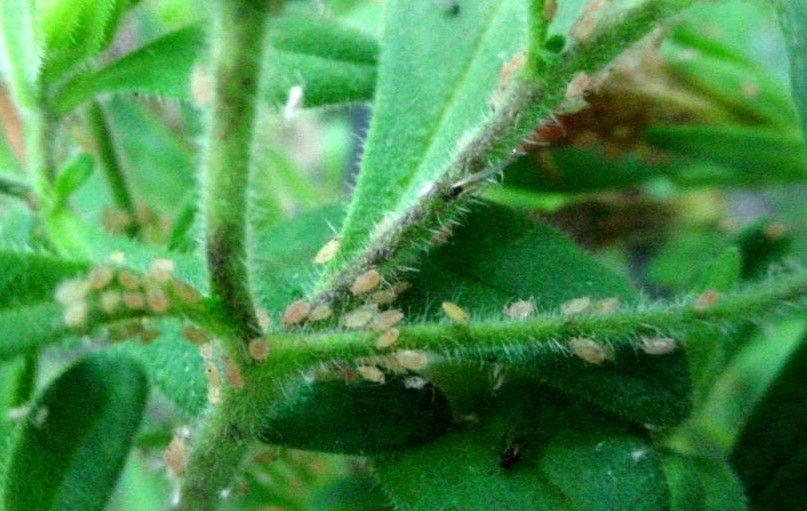
As the most common pest, aphids feed on petunias to get honeydew. They target the undersides of the leaves and spread through the buds and the stem. They can cause the leaves to wilt due to dehydration and discolored flowers.
One notable sign of aphid infestation is the sticky substance or honeydew residue on the leaves and buds of petunias. When the aphid problem is left untreated, the honeydew on the leaves may attract spores of bacterial and fungal diseases.
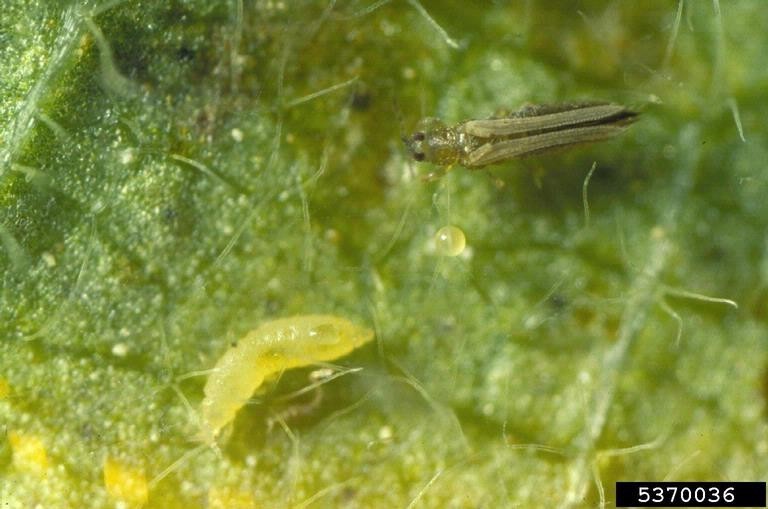
Thrips are needle-sized insects that feed on the leaves and flowers of petunias. They are the yellow, brown, or black insects that cause visible damage to leaves and flowers.
A sign of thrip infestation is the white patches on flowers and leaves. Thrips are also notorious for spreading plant viruses from one plant to another.
To know if you have a thrip problem, try to touch these insects, and you will notice them leaping or flying away. You may also shake the stem of your petunias and place a white cloth underneath to see the tiny brown specks of thrips.
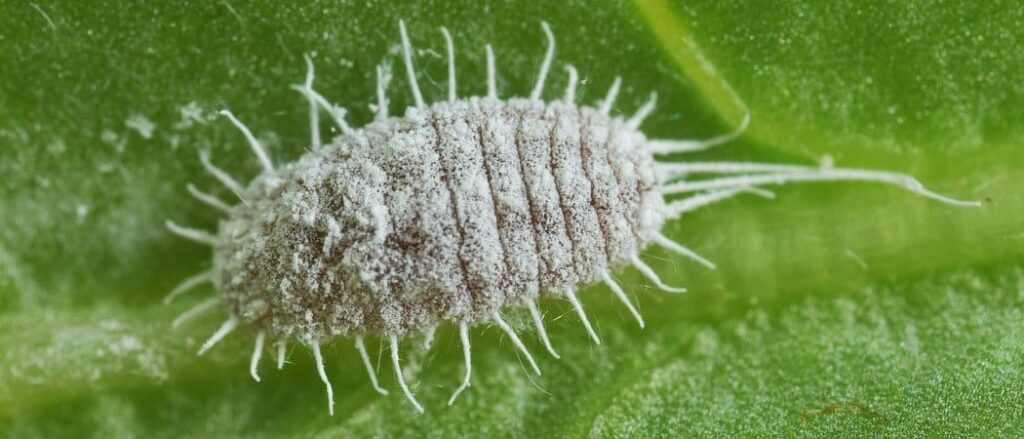
Lastly, mealy bugs! They are the tough-to-remove-white rounded specks on the underside of the leaves. They often look like white molds. Under a microscope, they look like a rounded centipede with several legs.
How to control sap-sucking insects on petunias
Here are some ways to control the tiny insects that have been eating your petunias:
(1) Water bombs: For mild infestations, the easiest way to remove aphids and thrips is to blast them off with water. Make sure to aim at the underside of the leaves, where they often hide.
(2) Organic insecticides: If you don’t want to use synthetic insecticides, soapy water is enough to control aphids and thrips. Mealybugs need to be thoroughly wiped down with soapy water because they clung tight to the leaves and stems.
(3) Horticultural and neem oil: Another option is using an organic insecticide like neem oil. Apply it early in the morning or at night to avoid burning the leaves. You may also use an insecticidal soap if neem oil is not working for your plants.
Spider Mites
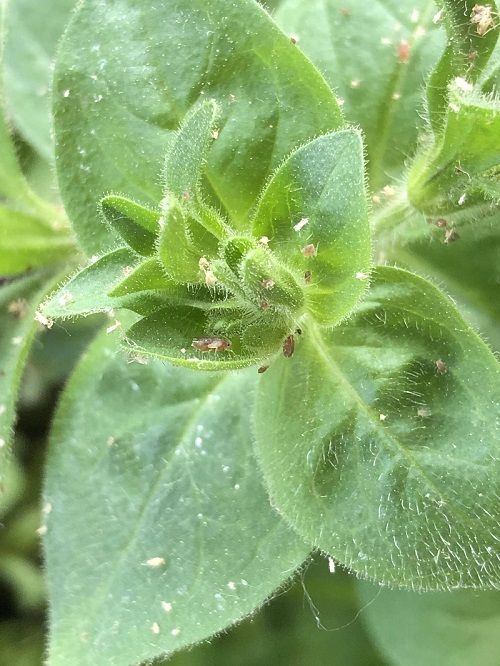
Spider mites are also notorious petunia pests causing discolored dots on the leaves until they dry up and fall from the plant. Compared to other insects, spider mites are easier to identify because of the tiny webs that they build behind them while feeding.
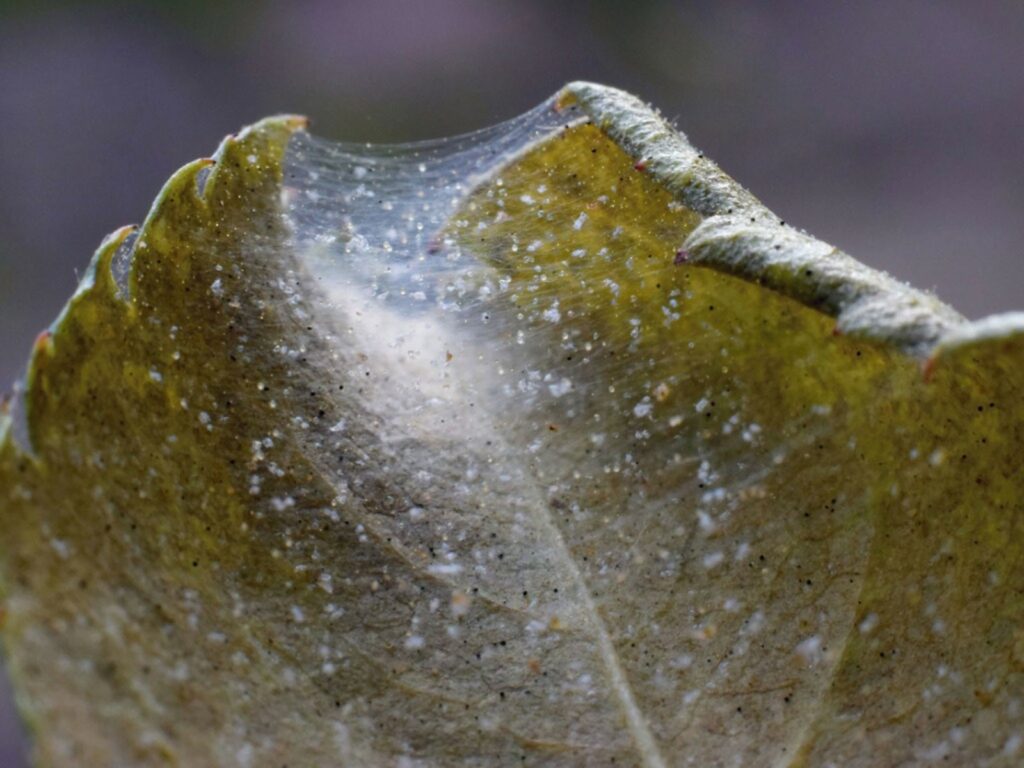
Like most sap-sucking insects, dry and hot weather of the summer season favors spider mites. They love attacking water-stressed plants. A small population of spider mites will not cause harm to petunias unless it is stressed or with a heavy spider mite infestation.
How to control mites on petunias
When the population of spider mites is already affecting the health of your petunias, here’s what you can do:
(1) Water bombs: Spraying pests away from the infested plants with water is a fool-proof solution. Be careful about damaging your plants if the water pressure is too strong.
(2) Insecticidal soap: Most gardeners recommend using insecticidal soap against spider mites for two reasons.
First, insecticidal soap does not contain harmful chemicals that may kill beneficial insects like bees.
Second, pyrethrin and pyrethroids are rich in nitrogen which encourages a further increase in the spider mite population.
In a research conducted by the University of California, the increased amount of nitrogen in leaves caused by pyrethrins and carbaryl favors the spread of spider mites. Nitrogen helps stimulate mite production, aggravating the pest problem.
(3) Neem oil: For persistent spider mite infestation, you may use a stronger approach using neem oil. Spray and wipe down the leaves of your petunias to remove the webs and allow the solution to reach the pests directly.
Since it is oil, you should only use it early in the morning so it can dry up on the leaves before noon and prevent burning the leaves.
Slugs and Snails

Petunias are not only swarmed by tiny insects but also chewed relentlessly by slugs and snails. Damp and dark planters are often the breeding ground for slugs and snails.
Like budworms, they create holes in the buds and feast on the leaves like the way you enjoy munching on lettuce. Since they have a bigger mouthpiece, several slugs feeding on a petunia plant can cause great damage to it.
Slugs, work them up to the flowers through the stem. They are long slimy black crawlers with antennae. One telltale sign of a slug infestation is the slimy trail they leave behind. They attack petunias at night, so bundle up your flashlight and gloves to handpick them.
How to control slugs and snails on petunias
Take the presence of the slug in your garden as a call to action in keeping it tidy. They love crawling around damp soil, dark planters away from the sun, and filled with dead leaves.
With that, here are some of the things that you can do to discourage the slugs into your garden:
(1) Lighten up the garden: If possible, try to trim your petunias or remove some obstacles to let the sunlight into your garden. Slugs hate direct sunlight because they dry out. You may also place your potted petunias in a sunny location wherein they can tolerate the heat.
(2) Plant some slug-deterrent plants like geraniums: Believe it or not, snails and slugs have a sense of smell and they hate the scent of some herbs and flowering plants like:
- Geraniums.
- Mint.
- Rosemary.
- Chives.
- Garlic.
- Lavender.
(3) Maintain a debris-free garden: Leaves and other debris in the garden create shade and a breeding ground for slugs and snails. Keep a garden cleaning routine to make it free from pests and other overwintering worms.
(4) Place a copper mesh around the petunia plants: Sprinkling anything on the soil to deter slugs may compromise the health of your petunias. Salt, for example, can dehydrate slugs but will also kill your petunias! So, the best solution is to use a copper mesh.
Slugs get irritated when they touch copper, making it the best option to place around your petunias. Rodents also hate it, so a roll can help you save your petunias and control the mice and rodent population on your property.
Create a tiny fence of copper mesh guided by stakes around your planters, and you’ll never see a slug feasting on your plants again.
Rabbits, Squirrels, and Deers
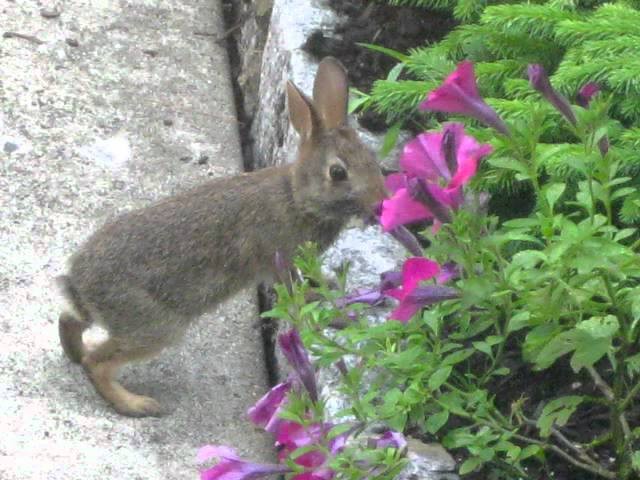
Like evergreens, petunias are also the target of some herbivores in the wild. These include rabbits, squirrels, and deer.
At the peak of summer, wildlife animals are stocking up on body fat to prepare for winter. So, they take advantage of the abundance of plants during spring and summer.
Deer, in particular, are elusive but sneaky at night. They target young pine trees, pumpkins, and even flowering plants like petunias. There’s a big chance that a deer has been sneaking up in your yard if the top part looks like they’re mangled by a big animal.
Rabbits and squirrels are easy to catch while they eat petunias. They usually reach for the lower part of the plant, collecting flowers that leave them with a mouth full of fresh flowers and leaves. Unlike deer, they attack in broad daylight.
How to repel wildlife animals on petunias
Though they are annoying, it’s inhumane to kill rabbits and deer for the sake of protecting a plant. The best approach for these pests is to deter them naturally. Here are some ways that you can try:
(1) Blood meal and bone meal: Blood and bone meal are made of animal bones and blood from slaughterhouses. They are used as fertilizers since they are high in nitrogen and help increase the acidity in the soil.
Rabbits and deer hate their smell, so you can use them to fertilize your petunias or during soil preparation.
(2) Metal fencing: Some homeowners also hate the smell of blood meal and the flies that come with it. The best way is to place a metal fence around the petunia planters. Rabbits can destroy plastic fences. They can also dig under the fence to get to the plant so consider cementing the base of the fence or placing some reinforced barrier underground.
(3) Rabbit repellent plant: If building a fence is too tedious, you can also use fragrant plants to keep wildlife at bay. These animals have a strong sense of smell. The scent of oregano, chives, and lavender will naturally discourage them from attacking your petunias.
Pest Control And Planting Tips For Growing Petunias
When dealing with pests, it pays to know their behavior before using any product. Any insecticide brand can claim that it can control any insects while some insects develop resistance to some types of insecticide.
To save you from spending on insecticides that don’t work and practices that will waste your time, here are some tips to consider:
- Bt solution has a weak effect on budworms and other bud-eating larvae. It can only work if the worms eat a part of the plant fully coated with Bt. Otherwise, they will continue feeding on unopened buds.
- Consider splashing your plants with water first before using anything. Sometimes daily or weekly splashes of water can severely deplete their population.
- Petunias can withstand and defend themselves from a pest infestation if they are healthy and free from any plant stresses. Ensure that they are watered, pruned, and fertilized at all times and pests will never be your concern unless you encounter a hungry deer, rabbit, or squirrel.
- You may consider planting them on hanging planters to keep ground pests from wreaking havoc on your petunias.
Frequently Asked Questions (FAQs)
Do petunias like sun or shade?
Petunias are sun-loving plants that require 5 to 6 hours of sunlight. They will produce more blooms and be healthier when exposed to the full sun the whole day.
How long do petunias last?
In warm climates, petunias can last for two or more years. However, in cold climates, they are considered annuals and die during winter.
How do you keep petunias blooming?
Place petunias in a sunny location for more blooms. They also love frequent pruning and trims to encourage new growth and blooms. Removing dead blooms, leaves and branches can also help reserve their energy for developing new blooms.
What do spider mites look like on petunias?
Spider mites are very tiny brown specks on petunias. Their webs often give them away on first look. They damage the leaves by creating dark spots until the whole leaf becomes yellow and dries up.
What are the little black specks on my petunias?
The black specks can either be thrips or droppings of budworms. If the black specks are not moving, they are indeed the excrement of budworms, which means you have to search for some green crawlies under the buds or on the stems. However, when the black specks fly or leap when you touch them, you are dealing with thrips.
What are the little white things on my petunias?
The white specks on petunias can be two things. It can be aphids or mealy bugs. If the white specks are very tiny, easy to remove by hand, and often congregate under the leaves, those are aphids.
If the white specks are rounded and look like molds, they are mealybugs. They are also harder to remove from the surface of the leaf than aphids.
Final Thoughts
We hope that this post helped you answer some of your questions about petunias. Due to the microscopic size of insects, it can be hard to identify them at first glance. As you navigate their behavior, it will soon be easier to identify them. Who knows you might even catch them in the act of eating your plants.
Petunias are resilient and easy to grow. However, just because they are resilient doesn’t mean you can neglect them with love and care. Pests can be hosts to several fungal diseases and doing a routine insecticide spray is already hitting two birds with one stone.
We hope that the next time you say: What is eating my petunias? You’ll be able to answer it immediately just by looking at the damage or the insect itself. May this post and your experience with pests help you become knowledgeable and confident about pest control.
